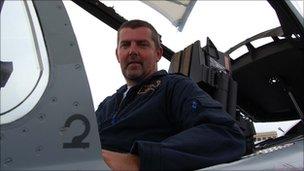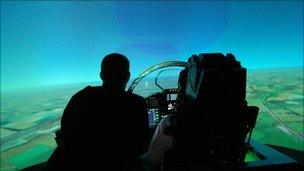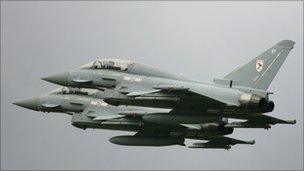Eurofighter Typhoon squares up to F-35 challenge
- Published

With defence budgets tight, some buyers are reviewing their orders for Eurofighter jets
Typhoon fighter jet test pilot Craig Penrice no longer flies.
Seven years ago he ejected from a jet with engine failure and ended up with a broken back and a new career.
These days Mr Penrice is a member of Eurofighter's business development team, pitching the Typhoon to air crews, air forces and defence ministries around the world.
"I want the boys who do the jobs I used to do to have the best equipment available," he says.
When the Typhoon was introduced in the mid 90s, Mr Penrice was the first Royal Air Force pilot to fly it.
The aircraft was built to meet criteria hammered out by four European defence ministries - those in the UK, Spain, Germany and Italy.
It is now in series production, being built by a consortium of European military manufacturers, including BAE Systems in the UK, the Finmeccanica subsidiary Alenia Aeronautica in Italy and the European aerospace and defence giant EADS.
"Eurofighter is a plane that's really found its time," BAE Systems' group business development director Alan Garwood tells the BBC.
"It's a multi-role combat aircraft that delivers for the Royal Air Force, for the Saudis and the other European nations that have bought it so far a really tremendous fourth generation capability that will survive for years."

Eurofighter's Craig Penrice says jets should be judged on performance, not politics
Fast and nimble
At Farnborough, BAE Systems test pilot Nat Makepeace looks relaxed as he gets ready for the mission of the day.
Mr Makepeace is preparing to fly a Eurofighter Typhoon, complete with six air-to-air missiles, four laser-guided bombs and three fuel tanks, in the air show aerial display.
"Fingers off buttons," he quips, though the biggest challenge will be the weight added to the fully loaded aircraft as he sets out to showcase the jet's manoeuvrability.
A trial in a flight simulator in the Eurofighter challet gives a taster of what he will have to contend with, and what the jet can do.
The Typhoon is a hugely capable fighter jet, according to Mr Penrice.
"In performance terms, it is very similar to an F-22," he insists, pointing to how both aircraft are very nimble and can fly at great heights and at high speed.
Ideal combinations

The Typhoon simulator hints at the jet's capabilities
In a world without political considerations, Eurofighter's Typhoon and Lockheed Martin's F-22 Raptor might have been rival multijet combat jets, according to Mr Penrice.
In the real world, however, they are not.
The Pentagon does not to permit Lockheed Martin to sell the much admired jet outside the US.
Instead, the Raptor programme was halted last year, effective from 2011, leaving the US Air Force with 187 F-22 Raptor jets.
The F-22 is to be used alongside the F-35 Lightning II, or Joint Strike Fighter, a jet currently in development. A similar and equally suitable jet combination for European nations could be the Typhoon and the F-35, Mr Penrice says.
Both combinations would benefit from the F-35's capabilities, which includes using it for bombing raids, with the speed and agility of either the Raptor or the Typhoon, he reasons.

About 100,000 European jobs are supported by the Eurofighter programme
Instead, in the world of defence budgets the F-35 has emerged as a rival to the Typhoon.
This was highlighted by a decision by Italy this week to cancel a 2bn euros order for its final 25 Typhoons - about a fifth of its original order - while at the same time saying it will go ahead and buy F-35 aircraft.
With defence budget cuts looming in the UK and elsewhere in Europe, many at Farnborough predict that other customers will follow suit.
The F-35 is often described as a fifth generation aircraft, and as such it could be deemed superior to the Typhoon.
But Mr Penrice disputes this, insisting they are both good planes, but they are built for different purposes.
Performance, price, politics
The F-35 cannot supercruise, it is not extremely agile, and its so-called stealth, or technology that makes it harder to detect, is limited, he claims.
Indeed, Mr Penrice even challenges the notion of fifth generation jets, insisting it is a term that seems to be mainly used for marketing purposes.
As such, he reasons, it creates "mis-understandings and spreads mis-information".
The way Mr Penrice sees it, three factors are considered when a fighter jet is chosen: performance, price and politics.
And these days, he insists, it is politics that rules.
For starters, when governments choose to pour money into a jet programme, they want industrial expertise and they want manufacturing jobs in return.
With the Typhoon, they have got that in spades, he insists, pointing out that some 100,000 European jobs are supported by the Eurofighter programme.
Many of those are the sort of jobs that maintain skills that enable Europe to remain autonomous rather than relying on the US, he reasons.
Key criteria
In the skies above Farnborough, Mr Makepeace wows the crowds with his aerial acrobatics.
But defence ministry and industry officials are also treated to a display by United States Air Force F-22 Raptor Aerial Demonstration Team Commander Major Dave 'Zeke' Skalicky, giving them first-hand views of the two planes' performance.
As a pilot, Mr Penrice would have liked performance to be the key criteria for countries choosing which fighter jets to buy.
But he also realises that defence budgets are cut both in Europe and the US, price and politics may play ever greater roles going forward.
And with many countries being "unwilling to move away from American products" for political reasons, he fears some pilots will be flying the wrong jets for their missions.